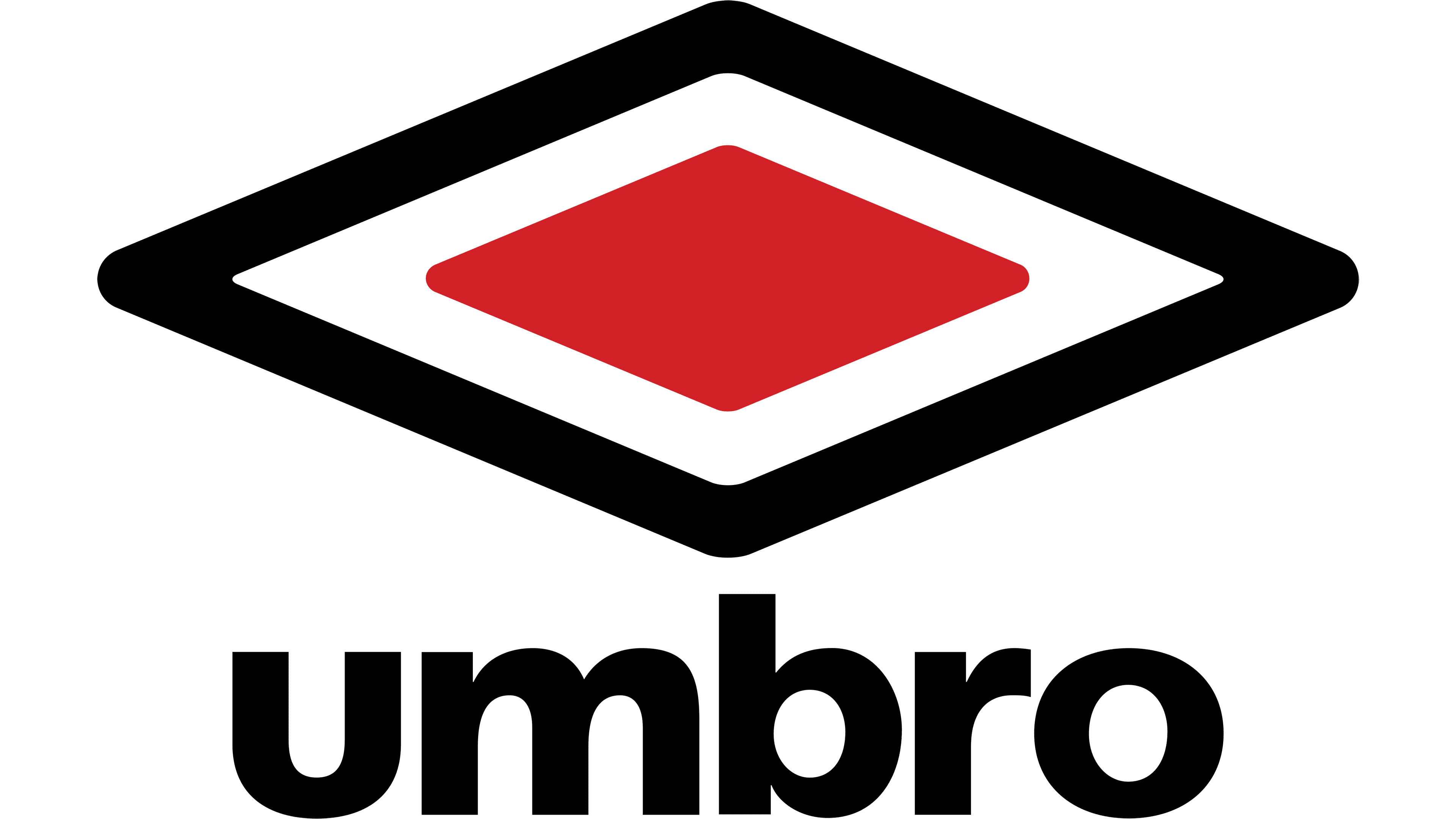Umbro Logo
Umbro is a renowned British sportswear and football equipment supplier established by the Humphreys brothers in Wilmslow, England. Initially forged to outfit athletes with high-quality football kits, Umbro has evolved into a global brand, synonymous with soccer around the world. Famous for its double diamond logo, the company has expanded its offerings to include apparel, footwear, and equipment, catering to both professional athletes and sports enthusiasts alike.
Meaning and history
Founded in 1924 in Wilmslow, England, by the Humphreys brothers. Umbro initially focused on football kits. It quickly became iconic, with a double diamond logo. The brand supplied kits for the English FA Cup final in 1934. Growth continued, and by the 1960s, it was outfitting top football teams worldwide. Umbro expanded into other sports but remained football-centric. The 1990s saw global expansion, sponsoring national teams and clubs. Despite challenges, Umbro maintained its football heritage. It was acquired by Nike in 2007, then sold to Iconix Brand Group in 2012. Umbro combines tradition with modern sportswear, still beloved in football.
What is Umbro?
Umbro stands as a quintessential British brand, carving its niche in the sportswear arena since 1924, primarily focusing on the heart of football culture. Emblematic for its iconic double diamond logo, the brand intertwines heritage with contemporary design, outfitting athletes and fans in a blend of tradition and modern flair.
1924 – 1930
The logo captures attention with its stark black-and-white color scheme, featuring the word “Umbro” prominently in a bespoke, bold font that leans forward, suggesting dynamism and movement. Encased within a diamond that points sharply to both ends, it mirrors the precision and cutting-edge nature of the brand’s association with sports. The design exudes a classic yet contemporary feel, evoking the brand’s storied heritage in athletic wear while appealing to modern aesthetics.
1930 – 1960
In this evolution of the logo, the word “Umbro” is infused with a sense of boldness, its letters now uniformly capitalized and thickened, exuding confidence. The letters are tightly nestled within the elongated diamond, enhancing the visual impact of the design. This iteration ditches any embellishments for a cleaner, more modern aesthetic, focusing purely on the stark contrast and the strength of the geometric shape. The starkness of the black diamond against the white letters creates a striking visual simplicity.
1960 – 1974
The logo retains its black and white contrast, yet the letters now exhibit a subtle change in typography, appearing more streamlined and modern. The “O” in “Umbro” is distinctly rounder, providing a visual balance to the angularity of the diamond. This rendition seems to emphasize simplicity and balance, speaking to a modern identity while respecting its heritage.
1974 – 2002
This logo distills the essence of Umbro to a minimalist series of nested diamonds, a departure from any lettering. The design emphasizes the iconic double diamond, which has become synonymous with the brand. Stripping away the text, the logo trusts in the power of its established imagery to convey the brand’s identity. It’s a bold move towards abstraction, suggesting a universal language of design that transcends the need for words.
1980 – 1996
The logo reintroduces the “Umbro” wordmark beneath the familiar double diamond, reaffirming its brand identity through text. The font is modern, sans-serif, and unembellished, prioritizing clarity and readability. This design marries the abstract geometry of the symbol above with the concreteness of the brand’s name, anchoring the logo in both symbolic and literal representation. It’s a harmonious blend of iconography and typography, clear and unmistakable in its branding intent.
1990 – 2002
The updated logo maintains the bold, black-and-white motif, yet streamlines the design further. The word “UMBRO” now sits directly below the double diamond, creating a more unified and compact visual. Typography is key in this rendition, with the letters of “UMBRO” appearing bolder and more pronounced, ensuring instant recognition. The overall effect is one of cohesion and strength, with the tighter alignment of symbol and text projecting a modern, assertive brand identity.
2000 – 2012
The logo retains its foundational elements but introduces a subtle refinement in the typeface of “umbro”, opting for lowercase, which softens its presence and offers a contemporary edge. The diamond emblem above, unchanged in shape, now features a thinner outline, enhancing the visual flow and reducing the overall weight of the design. This aesthetic shift suggests a more approachable and modernized brand, aligning with the new millennium’s design sensibilities.
2008 – 2024
The logo returns to a bold statement, discarding the lowercase for a robust, all-caps font that demands attention. The diamond emblem remains central but tilts, adding a dynamic, forward-moving angle. This shift implies action and progress, resonating with the energetic nature of sports. The logo’s black and white contrast is now sharper, with the white space within the diamonds more pronounced, creating a striking visual punch that stands out with confident simplicity.
2013 – 2024
This iteration of the logo reverts to a horizontal orientation, signaling a return to classic stability. The word “umbro” is now lowercase, conveying a modern, accessible brand voice. The diamond emblem, centered and symmetrical, remains a steadfast symbol of the brand’s legacy. This design harmonizes the boldness of tradition with the sleekness of the present, reflecting a timeless yet contemporary identity.
2024 – Today
The logo introduces a splash of color with a central red diamond, adding a vibrant contrast to the stark black and white. The “umbro” text remains in lowercase, maintaining a consistent, modern look, yet now gains additional prominence through the added color dynamic. This new hue breathes life into the design, symbolizing passion and energy, traits synonymous with the sports for which Umbro is known. The design evolution speaks to a brand that’s bold and evolving while staying true to its iconic roots.





















